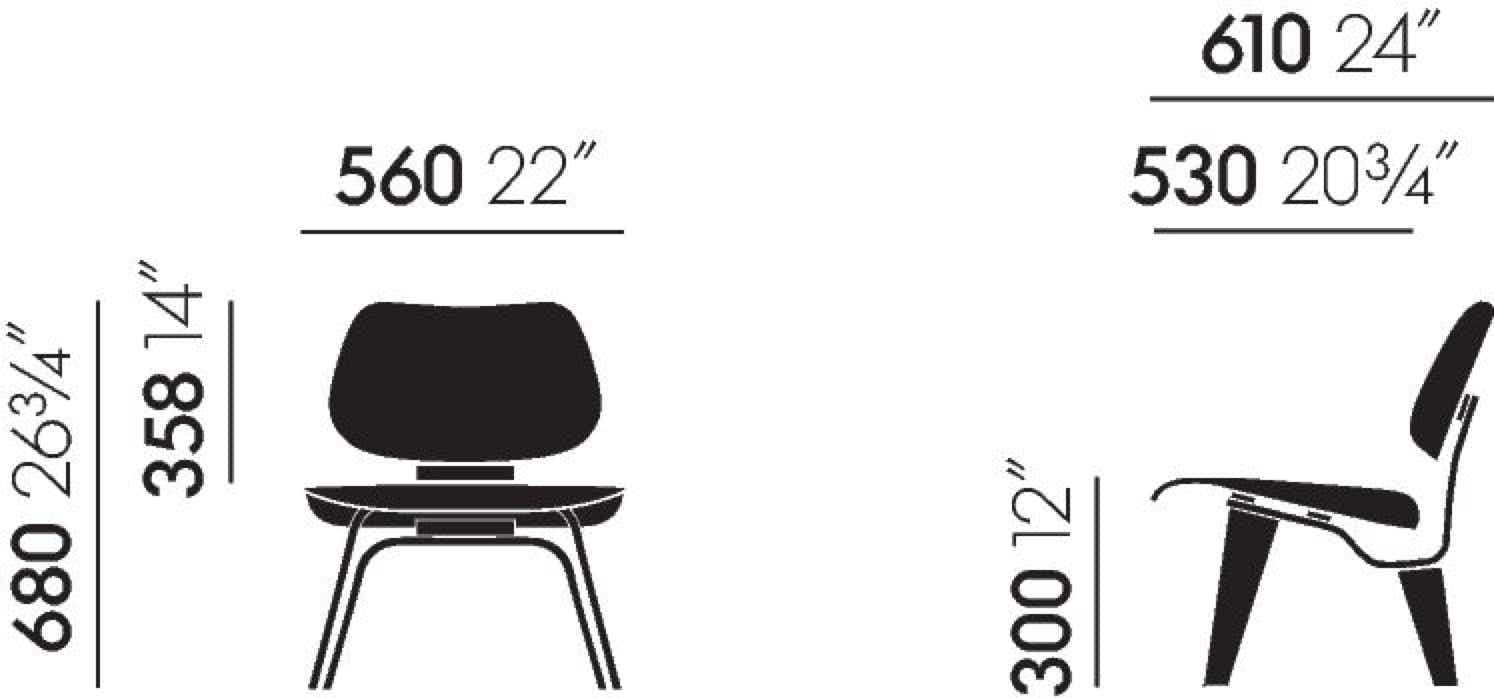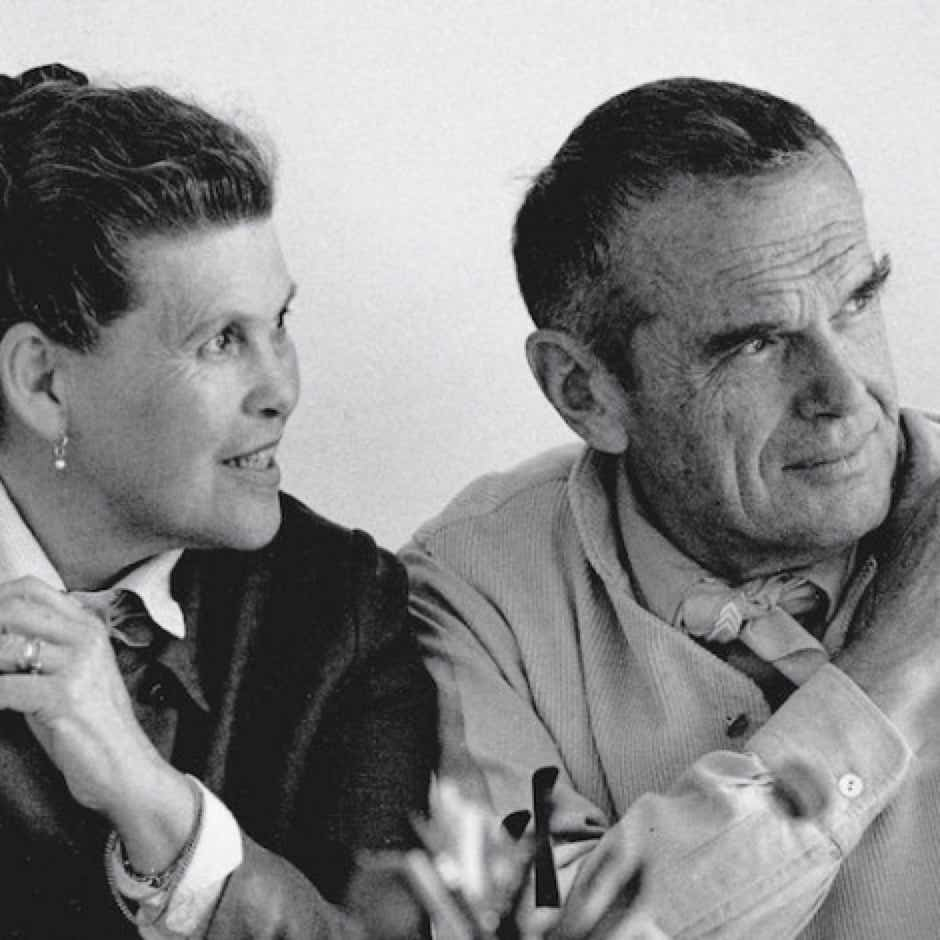Charles and Ray Eames spent many years experimenting with new techniques for producing three-dimensionally moulded plywood seat shells that conformed to the contours of the human body. They achieved this with the chairs in the Plywood Group, which have matured into classics with an appearance that still looks contemporary today. For the Plywood Group, they also combined chair tops with different bases.
Thanks to the organic shape of the plywood shells and the slightly flexible backrests, these light and compact chairs are extremely comfortable – also in the versions without upholstery.
The Plywood Group chairs are available in 2 versions: LCW (Lounge Chair Wood) with a wooden base or LCM (Lounge Chair Metal) with a chrome-plated tubular steel base. The LCW lounge chair is available without upholstery – in natural ash, in black ash or in red ash – or in a lightly upholstered version with a calf's skin – natural ash + brown/white skin, or black ash + black/white skin – or leather cover – natural ash + chocolate leather, or black ash + black leather. The seat and backrest are attached to the moulded plywood base with shock mounts (bonded rubber and metal connectors).
Seat and Back moulded plywood with ash or walnut veneer
Base moulded plywood with ash or walnut veneer, connected to the seat and back by rubber and metal elements (shock mounts)
Dimensions H68 x L56 x P53cm. Seat Height 30 cm (32 cm with padding)
Optional padding foam + leather or calf skin


CHARLES & RAY EAMES

Charles Eames, born 1907 in St. Louis, Missouri, studied architecture at Washington University in St. Louis and opened his own office together with Charles M. Gray in 1930. In 1935 he founded another architectural firm with Robert T. Walsh. After receiving a fellowship in 1938 from the Cranbrook Academy of Art, he moved to Michigan and assumed a teaching position in the design department the following year. In 1940, he and Eero Saarinen won first prize for their joint entry in the competition "Organic Design in Home Furnishings" organized by the New York Museum of Modern Art. During the same year, Eames became head of the department of industrial design at Cranbrook.
Ray Eames, born Bernice Alexandra Kaiser, was born in Sacramento, California in 1912. She attended the May Friend Bennet School in Millbrook, New York, and continued her studies in painting under Hans Hofmann through 1937. During this year she exhibited her work in the first exhibition of the American Abstract Artists group at the Riverside Museum in New York. She matriculated at the Cranbrook Academy of Art in 1940.
Charles and Ray Eames married in 1941 and moved to Los Angeles, where together they began experimenting with techniques for the three-dimensional moulding of plywood. The aim was to create comfortable chairs that were affordable. However, the war interrupted their work, and Charles and Ray turned instead to the design and development of leg splints made of plywood, which were manufactured in large quantities for the US Navy. In 1946, they exhibited their experimental furniture designs at MoMA. The Herman Miller Company in Zeeland, Michigan, subsequently began to produce Eames furniture. Charles and Ray participated in the 1948 'Low-Cost Furniture' competition at MoMA, and they built the Eames House in 1949 as their own private residence. In addition to their work in furniture design and architecture, they also regularly turned their hand to graphic design, photography, film and exhibition design.
In 1957 Vitra signed a licence agreement with Herman Miller and began producing the Eameses' designs for Europe and the Middle East. Charles and Ray Eames have had a profound and lasting influence on Vitra. It was the encounter with their work that spurred the company's beginnings as a furniture manufacturer. Yet it is not just the products of Charles and Ray Eames that have left a mark on Vitra. Even today, their design philosophy continues to significantly shape the company's values, orientation and goals.
Price Guarantee
Offering design at the right price is an integral part of our work. If you find the same item at a lower price at another retailer, delivery included, we will not only match it, but even offer you a better price.
How to take advantage of it?
We compare our prices every day with all authorized retailers in Europe. If nevertheless you find cheaper, contact us for a counter-proposal.
We must be able to verify that the item is authentic, new, perfectly identical (size, materials, color, etc.)
and that it is not part of a campaign or temporary destocking.
The valid basis is, for example, a current quote or a direct link to another retailer's website where the lower price is indicated. An email image is invalid, the original email must be forwarded.
The offer does not apply to orders already placed and cannot be combined with any of our other offers or promotions.